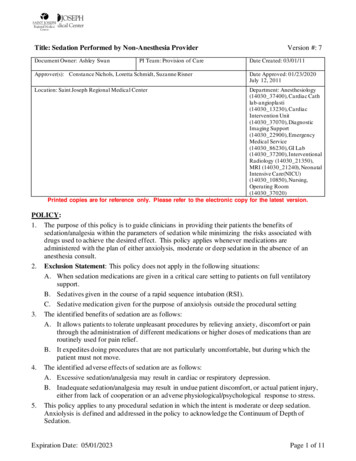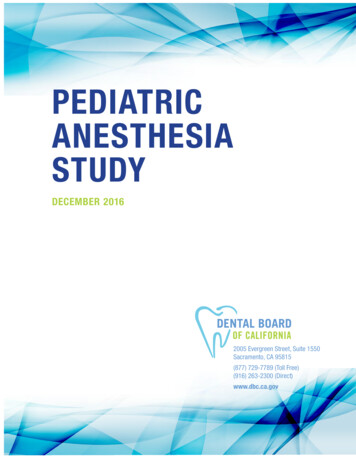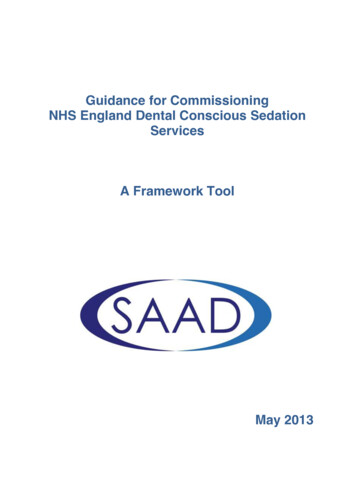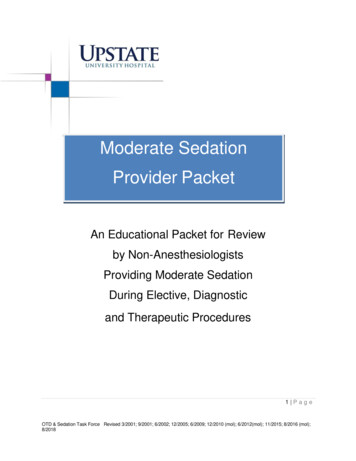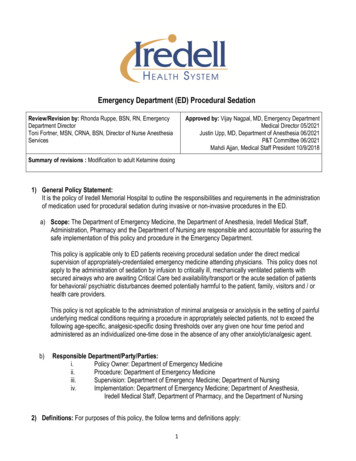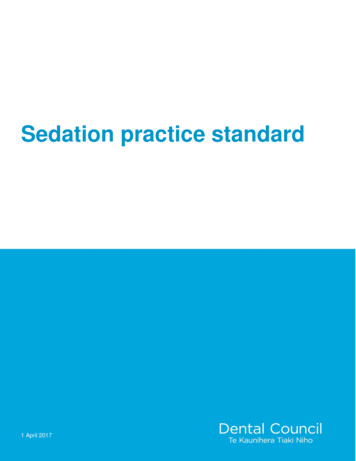
Transcription
CONSCIOUS SEDATION IN THE PROVISION OF DENTAL CARESTANDING DENTAL ADVISORY COMMITTEEConscious SedationIn The Provision of Dental CareReport of an Expert Group on Sedation forDentistryCommissioned by the Department of Health20031
CONSCIOUS SEDATION IN THE PROVISION OF DENTAL CAREA copy of this document can be found on:www.doh.gov.uk/sdac and www.doh.gov.uk/dentalIf you do not have access to the Internet, further copies ofthis document can be obtained from:Gillian FarnfieldDepartment of HealthRoom G10Wellington House133-155 Waterloo RoadLondon SE1 8UG2
CONSCIOUS SEDATION IN THE PROVISION OF DENTAL CARECONTENTSPageForeword7Executive .Definition of Conscious Sedation155.Educational and Training Standards165.1Theory175.2Practical skills175.2.1 Drugs and equipment5.2.2 Complications6.Clinical Training177.Provision of Education and Training183
CONSCIOUS SEDATION IN THE PROVISION OF DENTAL CARE8.Environment for Sedation9.Equipment for Nitrous oxide/oxygenInhalation Sedation181910.Equipment for Intravenous Sedation1911.Indications for Conscious Sedation2012.Responsibilities of a referring dentist2013.Patient Assessment and Selection2013.1 History2013.2 Examination2014.Contraindications2115.Preparation of patients2116.The Consent Process2317.Records and Documentation2418.Aftercare2518.1 Recovery2518.2 Discharge264
CONSCIOUS SEDATION IN THE PROVISION OF DENTAL CARE18.3 Aftercare Instructions26Conscious Sedation Techniques2619.1 Introduction2619.2 Monitoring2719.3 Inhalation sedation2719.4 Intravenous sedation2819.5 Oral/Intranasal/Transmucosal Sedation28Conscious Sedation for Children2820.1 Inhalation Sedation2920.2 Intravenous Sedation2920.3 Oral/Intranasal/Transmucosal Sedation2921.Complications3022.Clinical Governance3019.20.References31Members of Working Party35Appendix 1 (Contact details of supporting36organisations)5
CONSCIOUS SEDATION IN THE PROVISION OF DENTAL CARE6
CONSCIOUS SEDATION IN THE PROVISION OF DENTAL CAREFOREWORDA Conscious Decision, the report of an expert group, chaired by the Chief MedicalOfficer and my predecessor as Chief Dental Officer, was published in 2000. This builton the recommendations of a number of previous working groups which emphasisedthat general anaesthesia for dental treatment should only be used when there is noother method of pain and anxiety management appropriate for that patient. That reportrecommended that when a general anaesthetic is considered necessary it should beprovided in the safest way possible. This led to general anaesthesia for dentistry beingconfined to a hospital setting where there is the immediate availability of a critical carefacility.This change has resulted in a considerable reduction in the number of generalanaesthetics being undertaken and a growing use of conscious sedation in bothprimary care and hospital settings. It is essential that where conscious sedation iscarried out it is provided to the highest possible standards. Recognising the need forclarity about the appropriate standards for conscious sedation the Standing DentalAdvisory Committee established an expert group to make recommendations on goodpractice. This report provides recommendations for all practitioners providingconscious sedation whether in primary care or in hospitals. It underlines: the importance of the referring dentist and the sedationist considering alternativemethods of pain and anxiety control and discussing these with the patient beforedeciding that conscious sedation is appropriate. the need for both theoretical and practical training, continuing updating and clinicalaudit for the whole dental team is stressed as part of the clinical governanceframework for ensuring the delivery of a high quality service; and the necessity of having the appropriate equipment and drugs and ensuring thatthat the equipment is properly maintained.7
CONSCIOUS SEDATION IN THE PROVISION OF DENTAL CAREI am most grateful to John Lowry and all of the members of the Working Party forproviding this report. The recommendations should be noted and implemented by alldentists, especially those who provide conscious sedation. It will be important tomonitor the way in which conscious sedation is carried out and to undertake researchinto possible further improvements in materials and techniques. In this way conscioussedation will continue to provide a safe and effective method of pain and anxietymanagement.Professor Raman BediChief Dental Officer for EnglandOctober 20038
CONSCIOUS SEDATION IN THE PROVISION OF DENTAL CAREEXECUTIVE SUMMARYqDespite the publication of a number of authoritative documents on pain and anxietycontrol for dentistry it has become evident that there remain areas of confusion andlack of consensus. [1]qThis document is designed to lay down specific recommendations to allpractitioners providing Conscious Sedation for the provision of dental care ingeneral dental practice, community and hospital settings. [2]qThe effective management of pain and anxiety is of paramount importance forpatients requiring dental care and Conscious Sedation is a fundamental componentof this. [2]qCompetently provided Conscious Sedation is safe, valuable and effective. [2]qIt is absolutely essential that a wide margin of safety be maintained betweenConscious Sedation and the unconscious state of general anaesthesia. ConsciousSedation must under no circumstances be interpreted as light generalanaesthesia. [2]qA high level of competence based on a solid foundation of theoretical and practicalsupervised training, progressive updating of skills and continuing experience is thekey to safe practice. [2]qEducation and training must ensure that ALL members of the dental team providingtreatment under Conscious Sedation have received appropriate supervisedtheoretical, practical and clinical training. [5]qTraining in the management of complications in addition to regularly rehearsedproficiency in life support techniques is essential for all clinical staff. Retention andimprovement of knowledge and skills relies upon regular updating. [5.2.2]qOperating chairs and patient trolleys must be capable of being placed in the headdown tilt position and equipment for resuscitation from respiratory and cardiacarrest must be readily available. [8]9
CONSCIOUS SEDATION IN THE PROVISION OF DENTAL CAREqDedicated purpose-designed machines for inhalational sedation should be used.[9]qIt is essential to ensure that hypoxic mixtures cannot be delivered. [9]qThere should be adequate active scavenging of waste gases. [9]qAll equipment for the administration of intravenous sedation including appropriateantagonist drugs must be available in the treatment area and appropriatelymaintained. [10]qSupplemental oxygen delivered under intermittent positive pressure together withback up must be immediately available. [10]qIt is important to ensure that each exposure to Conscious Sedation is justified.Careful and thorough assessment of the patient ensures that correct decisions aremade regarding the planning of treatment. [11.3]qA thorough medical, dental and social history should be taken and recorded prior toeach course of treatment for every patient. [13]qThere are few absolute contraindications for Conscious Sedation however specialcare is required in the assessment and treatment of children and elderly patients.[14]qPatients must receive careful instructions and written valid consent must beobtained. [15]qFasting for Conscious Sedation is not normally required however some authoritiesrecommend the same fasting requirements as for general anaesthesia. [15]qRecovery from sedation is a progressive step-down from completion of treatmentthrough to discharge. A member of the dental team must supervise and monitor thepatient throughout this period. [18]10
CONSCIOUS SEDATION IN THE PROVISION OF DENTAL CAREqThe decision to discharge a patient into the care of the escort following any type ofsedation must be the responsibility of the sedationist. [18.2]qThe patient and escort should be provided with details of potential complications,aftercare and adequate information regarding emergency contact. [15]qThe three standard techniques of inhalation, oral and intravenous sedationemployed in dentistry are effective and adequate for the vast majority of patients.The simplest technique to match the requirements should be used. [19.1] The only currently recommended technique for inhalation sedation is a titrateddose of nitrous oxide with oxygen and it is absolutely essential to ensure that ahypoxic mixture cannot be administered. [19.3] The standard technique for intravenous sedation is the use of a titrated dose ofa single drug; for example the current use of a benzodiazepine. [19.4] Oral premedication with an effective low dose of a sedative agent may beprescribed. [19.5] qNo single technique will be successful for all patients. [19.1]All drugs and all syringes in use in the treatment area must be clearly labelled andeach drug should be given according to accepted recommendations. [19.1]qStringent clinical monitoring during the procedure is of particular importance and allmembers of the clinical team must be capable of undertaking this. [19.2]qConscious Sedation for children must only be undertaken by teams which haveadequate training and experience. [20] Nitrous oxide / oxygen should be the first choice for paediatric dental patients.[20.1] Intravenous sedation for children is only appropriate in a minority of cases.[20.2]11
CONSCIOUS SEDATION IN THE PROVISION OF DENTAL CAREqThe management of any complication including loss of consciousness requires thewhole dental team to be aware of the risks, appropriately trained and fullyequipped. It is vitally important for the whole team to be prepared and regularlyrehearsed. [21]qAttention must be given to risk awareness, risk control and risk containment. [21]qEvidence of active participation in continuing professional development (CPD) andpersonal clinical audit is an essential feature of clinical governance. [22]12
CONSCIOUS SEDATION IN THE PROVISION OF DENTAL CARE1.PrefaceDespite the publication of a number of authoritative guidelines and reports on pain andanxiety control for dentistry it has become evident that there remain some areas wherethere is an element of confusion or lack of consensus.An Intercollegiate Working Party established under the auspices of the Academy ofMedical Royal Colleges (AoMRC) and chaired by the Royal College of Anaesthetistsconsidered standards of sedation in medical and dental practice and developed inNovember 2001 generic guidelines entitled Implementing and Ensuring Safe SedationPractice for Healthcare Procedures in Adults 1. The Working Party acknowledged thatthe dental profession had been much more effective in producing and followingappropriate guidelines on sedation techniques than had medicine in general.Nevertheless concern remained that sedative drugs were in some circumstances beingused inappropriately or contrary to published recommendations.The following recommendations are designed to fully endorse and build upon thegeneric guidance and lay down specific guidance for the practice of ConsciousSedation in the provision of dental care.2.IntroductionThe effective management of pain and anxiety is of paramount importance for patientsrequiring dental care and Conscious Sedation is a fundamental component of this.Competently provided Conscious Sedation is safe, valuable and effective.It is absolutely essential that a wide margin of safety is maintained between ConsciousSedation and the unconscious state of general anaesthesia where verbalcommunication with the patient and protective reflexes are lost. In the case of patientswho are unable to respond to verbal contact even when conscious the normal methodof communicating with them must be maintained. A high level of competence based ona solid foundation of theoretical and practical supervised training, progressive updatingof skills and continuing experience is the key to safe practice. It is important that thereis a clear understanding by the patient (or where appropriate the parent or carer), the13
CONSCIOUS SEDATION IN THE PROVISION OF DENTAL CAREsedationist and all the team that Conscious Sedation must under no circumstancesbe interpreted as light general anaesthesia.These recommendations are directed to all practitioners providing Conscious Sedationfor the provision of dental care in general dental practice, community and hospitalsettings. They aim to promote good clinical practice with the techniques referred tobeing appropriate for use by an operator-sedationist where the practitioner carrying outthe dental treatment also administers the Conscious Sedation supported at all times byan appropriately trained assistant. Their purpose is to ensure that the varioustechniques utilised continue to have a high level of safety and effectiveness. It is hopedthat they will assist colleagues to attain and maintain the high clinical standards whichall patients rightly expect.3.BackgroundIn 1990 the ‘Poswillo Report’ entitled General Anaesthesia, Sedation and Resuscitationin Dentistry prepared for the Standing Dental Advisory Committee (SDAC) heraldedconsiderable change in the provision of these services for dentistry3. In 1995 a reportby the Clinical Standards Advisory Group (CSAG) Dental General Anaesthesiarecommended standards for patient care, safety facilities and training for dentists,anaesthetists and supporting staff4. During this time the Society for the Advancementof Anaesthesia in Dentistry (SAAD) and the Association of Dental Anaesthetists (ADA)published guidelines in relation to contemporary clinical practice in both generalanaesthesia and conscious sedation5 6. In 1993 the Royal College of Surgeons ofEngland issued guidance on sedation by non-anaesthetists while in 1996 a JointFaculties report was specifically directed towards its use in dentistry7 8. More recentlyThe Dental Sedation Teachers Group (DSTG) has published curriculum guidance forundergraduates and recommendations for training of The Competent Graduate9 10.14
CONSCIOUS SEDATION IN THE PROVISION OF DENTAL CAREDuring 1998 the General Dental Council (GDC)12 in acknowledgement of concernsraised by Royal Colleges, their Faculties, the British Dental Association (BDA),specialist societies and the media introduced wide reaching amendments to its ethicalguidance Maintaining Standards. It endorsed the need for the provision of conscioussedation and crucially placed an immediate embargo on the continuing provision ofgeneral anaesthesia by non-specialist anaesthetists. This suddenly reduced the use ofgeneral anaesthesia as a demand led service in primary dental care.In July 2000 the report of an expert group chaired by the Chief Medical Officer andChief Dental Officer of the Department of Health (DH) in England A ConsciousDecision finally led to the confinement of general anaesthesia for dentistry within ahospital setting where there was immediate availability of a critical care facility11. Thisreport also made a number of recommendations concerning conscious sedationspecifically endorsing its provision by a trained operator-sedationist supported by anappropriately trained assistant.Concurrently, an Independent Expert Group representative of all branches of dentistrywas convened by the SAAD to consider Standards for Conscious Sedation in Dentistry.This document relies heavily on that report 2 and aims to provide specialty specificguidance for dentistry to complement the recommendations in Implementing andEnsuring Safe Sedation Practice for Healthcare Procedures in Adults 1.4.Conscious Sedation is defined as:A technique in which the use of a drug or drugs produces a state ofdepression of the central nervous system enabling treatment to be carriedout, but during which verbal contact with the patient is maintainedthroughout the period of sedation. The drugs and techniques used toprovide conscious sedation for dental treatment should carry a margin ofsafety wide enough to render loss of consciousness unlikely. It is of fundamental importance that the level of sedation must be such thatthe patient remains conscious, and is able both to understand and respond toverbal commands.15
CONSCIOUS SEDATION IN THE PROVISION OF DENTAL CARE This definition was originally proposed in the Wylie Report (1978,) 13 and has beenadopted by the GDC, DH, SAAD, DSTG and the National Dental AdvisoryCommittee in Scotland 14. However a subsequent document published by theScottish Intercollegiate Guidelines Network (SIGN) 33 extends the definition byincluding no interventions are required to maintain a patent airway, spontaneousventilation is adequate and cardiovascular function usually maintained. European and international definitions of sedation for dentistry and guidelines arebeing developed. The definition describes the state of Conscious Sedation, and does not attempt toprescribe how it is achieved. Specifically it is acknowledged that a number oftechniques involving the use of one or more drugs administered via different routeswill fulfil this definition provided that there is an adequate margin of safety. Any technique resulting in the loss of consciousness is defined as generalanaesthesia and in the UK ‘deep sedation’ is considered within this category. The practise of general anaesthesia under the guise of Conscious Sedation istotally unacceptable and must be strongly deprecated in view of the risk ofjeopardising patient safety.5.Educational & Training StandardsEducation and training standards must ensure that ALL members of the dental teamproviding treatment under Conscious Sedation have received appropriate supervisedtheoretical, practical and clinical training before undertaking independent practice.16
CONSCIOUS SEDATION IN THE PROVISION OF DENTAL CARE5.1TheoryAll the topics referred to throughout this document must be included within anytraining programme for Conscious Sedation.5.2Practical Skills5.2.1Drugs and EquipmentPractical training for both dentists and their assistants in the use ofdrugs and equipment used to provide Conscious Sedation and for themonitoring of patients should be completed prior to clinical training.5.2.2ComplicationsTraining in the management of complications related to ConsciousSedation in addition to the standard requirement for regularly rehearsedproficiency in life support techniques in the working location is essentialfor all dentists and their assistants and is desirable for non-clinicalsupport staff. Practitioners and their teams have an obligation to beconversant with current authoritative guidelines such as those issued bythe Resuscitation Council (UK)15.6.Clinical TrainingSupervised hands-on education, training and experience must be acquired bypractitioners administering sedation and by their assistants for EACH ConsciousSedation technique used. This may be provided in a variety of settings.The method and timespan allowed for acquisition of this supervised practice may varydepending upon local and individual circumstances. An appropriate number ofdocumented and supervised cases must be competently completed according to therecommendations specified by the relevant authorities and updated in line withchanges in contemporary practice. For example The Competent Graduate published by17
CONSCIOUS SEDATION IN THE PROVISION OF DENTAL CAREthe Dental Sedation Teachers Group provides guidance for undergraduate dentalstudents 9 while sedation assistants / nurses may follow the requirements of the Log ofPractical Experience for entry to the examination for the Certificate in Dental SedationNursing of the National Examination Board for Dental Nurses 39.7.Provision of Education and TrainingThis may be provided in-house in clinical areas where conscious sedation is practisedand/or in more formal courses such as the Standard Course on Conscious Sedation(England & Wales) 36. Those arranging such training for their staff have a duty toensure that the quality of training and trainers is appropriate and that all theoretical andpractical training is documented.Retention and improvement of knowledge and skills relies upon regular updating bymeans of appropriate refresher courses and a programme of continuing peer-reviewedassessment as a routine practice activity. The interval at which updated training isrequired will depend upon local circumstances but must be documented. Peerreviewed assessment should occur at least once a year.All Education and Training programmes must be regularly reviewed and updated totake account of contemporary accepted standards as promulgated by appropriateauthorities. Examples of bodies who currently publish these are listed as Appendix 1.8.Environment for SedationThere should be unimpeded ambulance access to the building. The treatment andrecovery areas must be large enough to allow adequate access for the dental careteam. As with all dental techniques the operating chair and all patient trolleys must becapable of being placed in the head-down tilt position and equipment for resuscitationfrom respiratory and cardiac arrest must be readily available.18
CONSCIOUS SEDATION IN THE PROVISION OF DENTAL CARE9.Equipment for Nitrous oxide/oxygen Inhalation SedationDedicated purpose-designed machines for the administration of inhalation sedation(formerly termed relative analgesia) for dentistry should be used. Such machinesshould conform to British Standards 16 and be maintained according to manufacturers’guidance with regular, documented servicing.Gas supply lines for inhalation sedation machines must be connected by noninterchangeable colour coded pipelines and it is essential that the whole systemcomplies with the contemporary standards. On installed pipework there should be alow pressure warning device and an audible alarm. It is essential that failsafemechanisms be in place to ensure that hypoxic mixtures cannot be deliveredNitrous oxide and oxygen cylinders must be stored safely with regard to currentregulations. Cylinders must be secured safely to prevent injury.Scavenging of waste gases must be active and sufficient to fully conform to currentCOSHH standards 16 17. Breathing systems should have a separate inspiratory andexpiratory limb to allow proper scavenging 1 8. Nasal masks should be close fittingproviding a good seal without air entrainment valves.10.Equipment for Intravenous SedationAll the appropriate equipment for the administration of intravenous sedation must beavailable in the treatment area including in-date sedation and appropriate antagonistdrugs, syringes, needles, cannulae, surgical wipes / tapes / dressings, tourniquets andlabels. Purpose-designed, calibrated and appropriately maintained equipment isrequired for all infusion techniques. Supplemental oxygen and the equipment and skillsto deliver it to the patient by intermittent positive pressure ventilation must beimmediately available together with back-up supply should the need arise. Allequipment must be regularly maintained and appropriate records kept.19
CONSCIOUS SEDATION IN THE PROVISION OF DENTAL CARE11.Indications for Conscious Sedation11.1Anxious or phobic patients, those with movement disorder or with physicaland/or mental disability who are unlikely to otherwise allow safe completion oftreatment and who would thus be denied access to dental care20.11.2To enable an unpleasant procedure to be carried out without distress to thepatient.11.3To avoid general anaesthesia. The long term aim for patients in whom longterm dental phobia could otherwise be induced or prolonged should be agraduated introduction of treatment under local anaesthesia if necessaryutilising conscious sedation as an intermediate stage. It is important to ensurethat each exposure to Conscious Sedation is justified.12.Responsibilities of a referring dentistHaving discussed alternative methods of pain and anxiety control with the patientreferring practitioners must satisfy themselves that the care ultimately offered onreferral is Conscious Sedation according to the agreed definition. Conscious Sedationtechniques for children are limited and for them this assurance takes on even greaterimportance.13.Patient Assessment and SelectionCareful and thorough assessment of the patient ensures that correct decisions aremade regarding the planning of treatment. All appropriate techniques including, wherenecessary general anaesthesia should be explored with the patient to ensure that whenrequired the most appropriate type of Conscious Sedation is selected on each occasionand administered in the correct environment by an appropriate practitioner.20
CONSCIOUS SEDATION IN THE PROVISION OF DENTAL CARE13.1HistoryA thorough medical, dental and social history should be taken and recordedprior to each course of treatment for every patient. This is directed to ensuringthat the method and nature of the Conscious Sedation technique chosen is themost appropriate to enable treatment to be carried out for the patient as anindividual, taking into account specific factors such as age, state of health,social circumstances and special needs.13.2ExaminationA provisional treatment plan should be formulated following the taking of ahistory, dental examination and assessment of the patient's general fitness.Assessment of general appearance, skin colour, pulse and respiration isimportant in the selection of appropriate treatment for each patient. Accuratemeasurement of blood pressure is an essential part of risk assessment forintravenous sedation. The American Society of Anesthesiologists (ASA)Physical Status classification should be determined and recorded 21.14.ContraindicationsThere are few absolute contraindications for Conscious Sedation. However relativecontraindications are important and can only be considered following a thoroughassessment of the patient which only thorough assessment provides. Especial care isrequired in the assessment and treatment modality selection for children and elderlypatients. Only patients in ASA classes I and II should normally be considered suitablefor sedation as outpatients 21. Patients in ASA class III should be referred to anappropriate secondary care unit.15.Preparation of PatientsPatients during preparation for Conscious Sedation must receive careful verbal andwritten instructions regarding its effects and their responsibilities both before andimmediately after it.21
CONSCIOUS SEDATION IN THE PROVISION OF DENTAL CAREFasting for Conscious Sedation is not normally required. Patients should generallybe advised to take only light food and clear non-alcoholic fluids prior to an appointmentfor Conscious Sedation. However some authorities recommend the same fastingrequirements as for general anaesthesia in view of the potential for depression of upperairways reflex sensitivity 37.It is important there is a clear understanding that Conscious Sedation must under nocircumstances be interpreted as light general anaesthesia.Specific written valid consent must be obtained for all patients who are to receivetreatment under sedation.A responsible adult escort must accompany the patient home or to a suitableplace of care after treatment under Conscious Sedation and assume responsibility forthe post-sedation care for the rest of the day. The provision of Conscious Sedation maytherefore be unsuitable for a patient who lives alone or who solely cares for children,elderly and / or dependent relatives. Both patient and escort must understand andaccept that this responsibility is delegated to the escort and both must agree to complywith this. It is therefore essential that each of these individuals clearly understand theeffects of sedative agents before arriving for the procedure and the consequences offailing to follow all post-sedation instructions.Wherever possible there should be arrangements in place for the patient and escort totravel home by private car or taxi rather than public transport. If this is not possible theescort must be made fully aware of the added responsibilities of caring for the patientduring the journey home. If either the patient or escort appear to be unwilling or unableto comply with these requirements Conscious Sedation should not be administered.For an adult receiving nitrous oxide / oxygen inhalation sedation this requirement isless rigid and each patient must be assessed individually.22
CONSCIOUS SEDATION IN THE PROVISION OF DENTAL CARE16.The Consent ProcessConsent should follow the principles set out in a Reference Guide to Consent forExamination or Treatment published by the Department of Health22 23.In advance of the procedure the patient must be given clear and comprehensive preand post-operative instructions in writing and written informed consent must beobtained. It is important to remember that the mere presence of a signature does notguarantee that the consent obtained is valid.For consent to be valid it must be given voluntarily by an appropriately informed person(the patient or where relevant someone with parental responsibility for a patient underthe age of 18 years) who has the capacity to consent to the intervention in question.Mere acquiescence where the person does not know what the intervention entails isnot ‘informed consent’. In the case of all adults who are unable to fully understand thenature and implications of the proposed treatment because of mental orsensory disability the appropriate consent or agreement to treat process must befollowed.Young people aged 16 years and over are presumed to have the competence to giveconsent for themselves. Younger children who fully understand what is involved in theproposed procedure can also give consent although their parents must whereverpossible be involved. In order to provide valid consent a patient must be able tocomprehend the information provided, retain and assimilate it so as
patients requiring dental care and Conscious Sedation is a fundamental component of this. [2] q Competently provided Conscious Sedation is safe, valuable and effective. [2] q It is absolutely essential that a wide margin of safety be maintained between Conscious Sedation and the unconscious state of general anaesthesia. Conscious Sedation must under no circumstances be interpreted as light .



